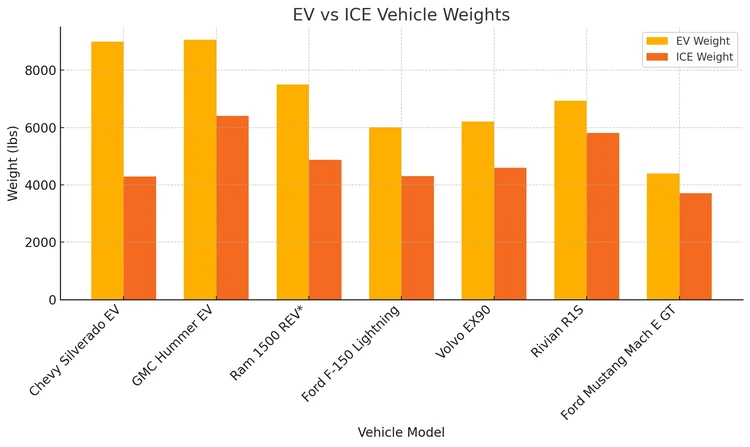Overweight and overpowered, big EVs pose a threat to everyone, Center for Auto Safety charges
June 2, 2025
-
New electric trucks and SUVs weigh up to 4,200 lbs more than their gas-powered counterparts
-
Extra weight increases fatal crash risk and worsens pedestrian safety
-
High-speed acceleration features in heavy EVs pose new threat to road users
As electric vehicles surge in popularity, safety experts at the Center for Auto Safety are raising urgent concerns over a less discussed but increasingly dangerous side effect: weight.
Modern electric trucks and SUVs can outweigh their gasoline counterparts by thousands of pounds, largely due to the massive batteries required for long-range performance. While EVs promise cleaner air and reduced emissions, the sheer mass of these vehiclesand their formidable accelerationcould create a new set of problems for drivers, pedestrians, and infrastructure.
Crashes deadlier, visibility worse
Bigger is not better when it comes to crash compatibility, the CAS analysts warn. Larger EVs often sit higher and feature bulkier front-end designs, making it harder to see pedestrians and smaller vehiclesespecially in scenarios like frontovers, where small children disappear from view just in front of the vehicle. In collisions, the added weight can be devastating.
For every additional 1,000 pounds in a vehicle, the risk of severe injury or death rises by nearly 50%, according to crash data. The impact is magnified as more electric pickups and SUVs hit the roads, some of which add over 1,500 pounds in battery weight alone.
Acceleration that outpaces skill
Compounding the weight problem is the lightning-fast acceleration many electric vehicles boast. The GMC Hummer EV, for example, features a WTF (Watts to Freedom) mode that launches the nearly 9,100-pound truck from 0 to 60 mph in just over 3 secondsperformance rivaling that of high-end sports cars.
These features are too much, too fast for the average driver, say the safety advocates, who suggest geofencing such modes to prevent their use near public roads and populated areas. Even without gimmick buttons, most EVs have instant torque and rapid speed potential that could catch untrained drivers off guard.
Weight gap widens
A comparison of leading EVs to their internal combustion engine (ICE) equivalents reveals just how significant the weight gap has become:

*Weight estimated for pre-production models
Source: Center for Auto Safety
These heavier vehicles contribute to faster road surface degradation, shorter tire life, and a rise in repair and maintenance costs. In cities, the growing fleet of superheavy EVs could also increase pedestrian fatalities, especially in underserved communities with limited safe walking infrastructure.
A cleaner future, but not without cost
EVs remain a key part of the transition away from fossil fuels. But advocates argue that if the industry continues to focus on size, power, and performance over safety and sustainability, the public could pay the price in lives, injuries, and long-term infrastructure damage.
EVs should help make the future safer and greenernot just cleaner, the CAS experts say. But right now, were building faster, heavier machines without asking who theyre safe for.
#Supersized #electric #vehicles #increase #hazards #road #critics